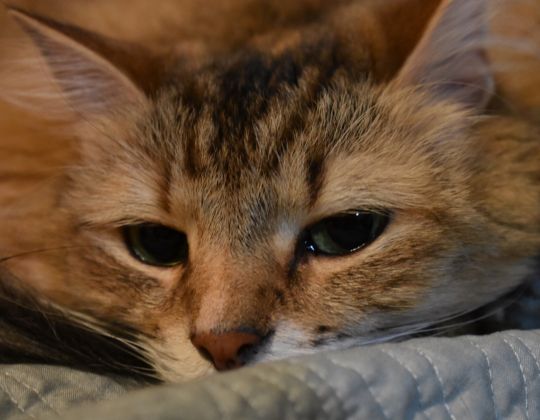Cats don’t cry tears of sadness, but their cries always mean something. Here’s how to understand them.
Many cat owners are puzzled by their cat’s sudden meows, watery eyes, or nighttime yowls. It’s natural to wonder: is my cat really crying? Cats clearly feel affection, stress, and even grief, but do they cry actual emotional tears like humans do? Let’s explore the truth behind the question: do cats cry?
No, cats do not cry emotional tears like humans. While their eyes can water due to issues like allergies, infections, or irritation, they don’t produce tears as a response to sadness. Instead, cats express emotions through meowing, body language, and changes in behavior.
Recognizing how cats express distress is the first step. Let’s look at what their “crying” really means.
Can Cats Cry Tears?
Cats have tear ducts, but they don’t produce emotional tears like humans. If you notice watery eyes, it’s usually due to a medical reason, not sadness.
Common causes of watery eyes in cats include:
- Allergies
- Conjunctivitis
- Eye irritation or scratches
- Dry eye (keratoconjunctivitis sicca)
- Respiratory infections
- Blocked tear ducts
So while it may appear that your cat cries tears, it’s almost always due to health-related issues, not emotional distress.
How Cats Communicate Through Crying Sounds
Cats express their needs through a variety of sounds that can resemble crying. Each sound has a purpose:
Meowing: A call for food, affection, or attention. Night meowing often signals loneliness or boredom.
Growling or Hissing: Signs of fear, irritation, or discomfort. The cat is asking for space.
Chirping or Trilling: Friendly, excited greetings are often used toward people or other animals.
Purring: Usually shows contentment, but may also occur during stress, pain, or illness as a self-soothing behavior.
Moaning or Wailing: Less common, but often associated with pain, anxiety, confusion, or old age.
Is It Crying or Normal Vocalizing?
Some cats are naturally chatty, and frequent meowing may simply be their personality. However, if the tone, volume, or behavior suddenly changes, it could indicate that something is wrong.
Look for additional signs like hiding, aggression, pacing, or appetite loss to determine if it’s more than just typical chatter.
6 Common Reasons for Vocalization and Watery Eyes
Do cats cry? Not like we do, but they do express distress through sound and physical symptoms like watery eyes. Here’s a closer look at what might be behind their cries.
1. Hunger or Attention-Seeking
Typical sound: Loud, repetitive meowing—especially around feeding time.
Some cats are more vocal than others, and if they’ve learned that meowing gets your attention, they’ll use it to their advantage. Indoor cats, in particular, rely on humans for all their needs and may meow persistently when they want food, interaction, or play.
Signs to watch for:
- Crying near the food bowl
- Following you around while vocalizing
- Meowing at doors or windows when ignored
This is one of the most common answers to the question, “Do cats cry for attention?” While it’s not emotional crying, it’s a clear form of communication.
2. Stress or Anxiety
Typical sound: High-pitched, unsettled meows or howls.
Cats are sensitive creatures. Any change in their environment or routine can lead to stress, which often manifests as vocalization. While cats don’t cry emotional tears, stress can still make them sound like they’re “crying.”
Common triggers include:
- Loud noises (fireworks, construction)
- Introduction of a new pet or family member
- Changes in furniture, routine, or territory
- Being left alone for long periods
Other signs of stress:
- Hiding or avoiding interaction
- Pacing or restlessness
- Overgrooming or grooming bald spots
- Decreased appetite or litter box issues
Providing a stable environment and calm routines can help reduce stress-induced vocalization.
3. Pain or Illness
Typical sound: Deep, prolonged yowls or sudden cries when touched or moved.
One of the more serious reasons a cat may cry is physical discomfort. Pain-related vocalizations are often more intense, urgent, or out of character. In these cases, the question isn’t just “can cats cry?”, it’s “is my cat trying to tell me something’s wrong?”
Potential medical causes:
- Urinary tract infections: Meowing while in or near the litter box
- Arthritis or joint pain: Crying during movement or when trying to jump
- Dental disease: Drooling, pawing at the mouth, or avoiding food
- Injuries or internal issues: Limping, sensitivity to touch, or sudden aggression
If your cat seems to be in pain and also has watery eyes (mistaken for tears), it’s time to call the vet. Cats are experts at hiding discomfort—vocalization is often a late warning sign.
4. Eye or Nasal Irritation
Typical sign: Watery eyes that may resemble emotional crying.
Cats don’t cry emotional tears, but their eyes can water due to various health issues. If you’ve noticed your cat cry tears, it’s more likely a response to irritation or infection than sadness.
Possible causes:
- Allergies: Dust, pollen, or household cleaners
- Eye infections (conjunctivitis): Redness, discharge, swelling
- Foreign bodies: Dust, hair, or debris trapped in the eye
- Upper respiratory infections: Common in kittens or shelter cats, usually accompanied by sneezing
While these symptoms might make it seem like your cat is crying, they are physical issues that need medical attention. Persistent eye watering should always be checked by a vet to prevent complications.
5. Mating Behavior (Unneutered Cats)
Typical sound: Intense yowling, especially at night.
Unspayed or unneutered cats often cry loudly as part of their mating instincts. This isn’t emotional crying—it’s hormonal and driven by the urge to breed.
Signs in females (in heat):
- Loud, drawn-out yowls
- Increased affection or rolling on the floor
- Restlessness and frequent attempts to get outside
Signs in males:
- Roaming and spraying
- Aggressive behavior toward other males
- Responding vocally to females in heat
This type of vocalization can be very disruptive. Fortunately, spaying or neutering significantly reduces or eliminates this behavior.
6. Cognitive Decline in Older Cats
Typical sound: Low, mournful cries, especially at night or in quiet areas.
Senior cats can develop feline cognitive dysfunction (FCD), which is similar to dementia in humans. Disorientation and confusion can cause them to cry, even when they’re not in pain.
Common signs of cognitive decline:
- Wandering aimlessly
- Getting “stuck” behind furniture or in corners
- Forgetting where the litter box is
- Crying for no apparent reason
If your older cat starts crying more often, especially during nighttime hours, it may be due to age-related changes in the brain. A vet can confirm the diagnosis and suggest management options.
Do Kittens Cry?
Yes, kittens cry more frequently than adult cats because they are still learning how to communicate. Kittens usually cry to express basic needs or discomfort.
- Hunger
- Feeling cold
- Loneliness
- Missing their mother or littermates
- Wanting comfort or attention
As they grow older, kittens meow less unless crying is unintentionally reinforced by human response. If your kitten is crying excessively, it’s best to rule out health issues and ensure they feel warm, fed, and safe.
Should I Comfort a Crying Cat?
Yes, but only when it’s appropriate. If your cat is crying due to fear, confusion, or discomfort, offering calm reassurance is helpful. However, it’s important not to reward attention-seeking cries with food or treats every time, as this may reinforce the behavior.
TIPS:
- Respond gently when your cat is upset, not just loud
- Avoid punishment, it increases stress
- Use calming cues like soft petting or your voice
- Offer enrichment (scratching posts, toys, window views) to reduce boredom-related vocalization
Watch for body language. A soft meow and slow blink is very different from a desperate howl.
When to See a Vet
You should consult your vet if:
- Your cat suddenly begins crying excessively
- There’s visible eye discharge or swelling
- Crying occurs when using the litter box or being touched
- Your cat shows other changes in behavior, appetite, or energy levels
Prompt attention can help rule out or catch early signs of illness or pain.
FAQs
Do cats cry emotional tears?
No, cats do not cry tears from sadness. While they may appear to cry due to watery eyes, this is almost always a physical issue like an infection or allergy. Cats express emotions through vocalizing, body posture, and behavior, not tears.
Why is my cat crying at night?
Nighttime crying may result from hunger, boredom, loneliness, anxiety, mating behavior, or age-related confusion. If it becomes frequent or intense, consult your vet.
Can I ignore my cat’s crying?
You should not ignore a cat’s crying without first understanding the cause. Occasional meowing is normal, but persistent or sudden vocalization may indicate pain, stress, or illness.
Final Thoughts
So, do cats cry? Not in the emotional, tear-filled way humans do—but they certainly do communicate distress, discomfort, and emotional needs in their own language. Whether it’s a meow for food, a wail of confusion, or watery eyes from a health issue, crying cats are speaking up.
Understanding what your cat is trying to say is the first step toward giving them the care and comfort they need.



